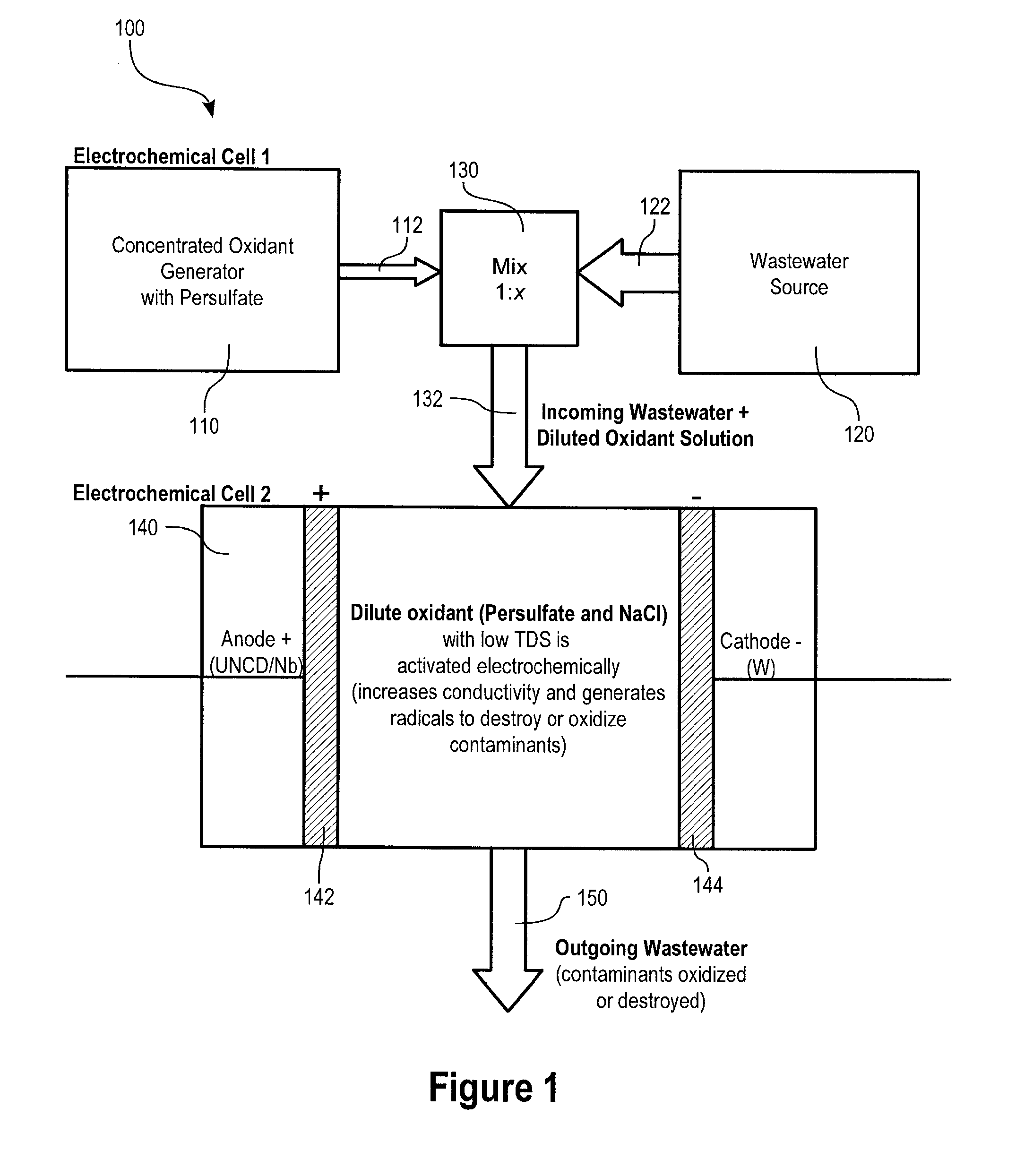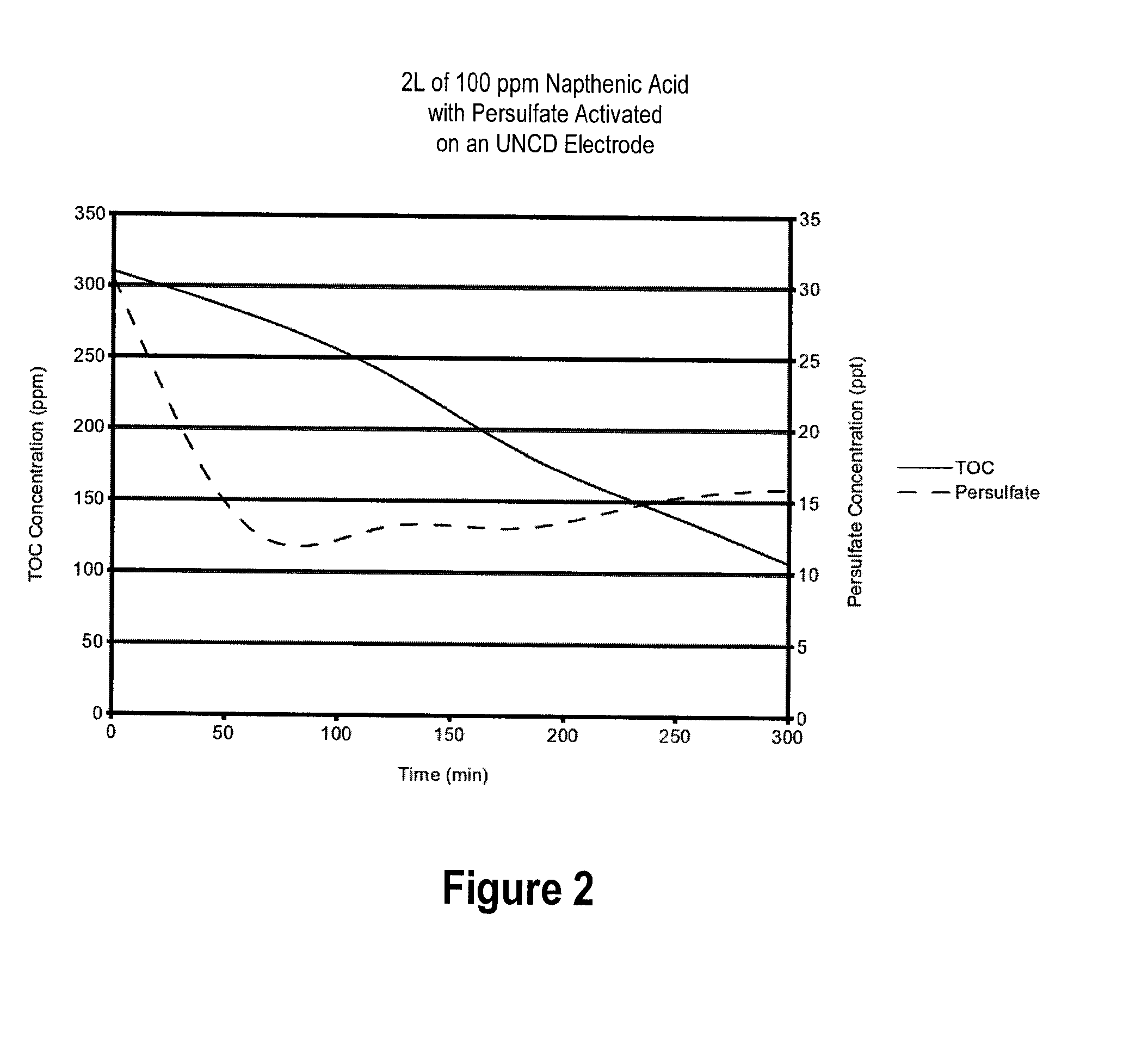System and Method for Treatment of Wastewater to Destroy Organic Contaminants by a Diamond Activated Electrochemical Advanced Oxidation Process
a technology of advanced oxidation and wastewater treatment, which is applied in the direction of energy-based wastewater treatment, electrolysis components, chemistry apparatus and processes, etc., can solve the problems of increasing fracking operations, time-consuming or expensive processes, and the activation process can be very energy-intensive and/or costly
- Summary
- Abstract
- Description
- Claims
- Application Information
AI Technical Summary
Benefits of technology
Problems solved by technology
Method used
Image
Examples
examples
[0054]Examples will now be described to illustrate the application of methods according to embodiments of the invention, i.e. diamond activated EAOP processes, for destruction of refractory organics including, for example: methanol, phenol, estradiol, methylene blue and napthenic acids, in an electrochemical system comprising ultrananocrystalline diamond (UNCD) electrodes for diamond activation of peroxy oxidant species.
example a
Destruction of Methylene Blue
[0055]Table I shows non-optimized diamond activated EAOP experiments with input persulfate (PS) and solar salt concentrations, cell operating conditions and calculated rates, current efficiencies and calculated operating (OPEX) and capital costs (CAPEX) for oxidative destruction of methylene blue (MB).
TABLE 1Experimental UNCD electrode activated Waste Remediation (Methylene Blue) resultsCAPEX atdiamond priceCurrentRate ofEnergyOPEX =of $60,000 / m2SolarEfficiencydestructioncost atEnergy +and electrodeCAPEX +SaltPSCellCurrentassuming(tonnes7 ¢ / kWhsalt + PSlife-time =OPEXmostlyS2O82−SolutionVoltageDensity4e- / molewaste / day-m2($ / tonne($ / tonne5 years($ / tonneNaCl (M)(M)Volume (L)(V)(mA / cm2)MB (%)of electrode)waste)waste)($ / tonne waste)waste)0.50.010.28.13001.1%11.4$357.21$360.87$3.00$360.870.50.010.26.41501.8%9.8$164.64$168.30$3.50$171.800.50.010.24.2304.3%4.6$45.75$49.41$7.50$56.910.50.010.23.81027.3%9.8$6.43$10.09$3.50$13.590.10.010.215.53000.9%9.8$797.48$800....
example b
[0058]Destruction of Napthenic Acid. In this example, experimental results are provided for oxidation and destruction of phenol and napthenic acid by electrochemically activated persulfate solutions. These results show the rate of destruction of the organic contaminant with time, as evidenced by spectrophotometry, together with the electrochemical regeneration of persulfate as oxidation of the organic contaminant proceeds towards completion (e.g. see FIG. 2). It is evident from the results presented below that, in this multistep process, the majority of the persulfate oxidant species are present in the mixture 132 of wastewater and diluted oxidant that enters the electrochemical cell 140, and subsequently these persulfate species are activated by the diamond electrode 142 to effect oxidation and destruction of the organic contaminants more rapidly and efficiently than other known processes. It is believed that, because a suitable concentration of persulfate or other peroxy oxidant s...
PUM
| Property | Measurement | Unit |
|---|---|---|
| current density | aaaaa | aaaaa |
| current density | aaaaa | aaaaa |
| current density | aaaaa | aaaaa |
Abstract
Description
Claims
Application Information
 Login to View More
Login to View More - R&D
- Intellectual Property
- Life Sciences
- Materials
- Tech Scout
- Unparalleled Data Quality
- Higher Quality Content
- 60% Fewer Hallucinations
Browse by: Latest US Patents, China's latest patents, Technical Efficacy Thesaurus, Application Domain, Technology Topic, Popular Technical Reports.
© 2025 PatSnap. All rights reserved.Legal|Privacy policy|Modern Slavery Act Transparency Statement|Sitemap|About US| Contact US: help@patsnap.com



